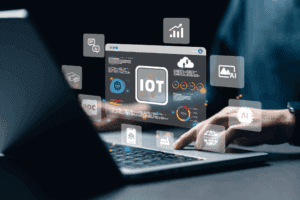Introduction – Embedded AI Powering AIoT
In the era of smart living, embedded AI is redefining how IoT devices interact with our daily routines. Imagine an office worker in a first-tier city: the smart wristband by their pillow, powered by embedded AI hardware, analyzes heart rate and sleep quality data from the night before. This information is processed locally using embedded deep learning algorithms before syncing to the home IoT gateway. The coffee machine starts brewing a low-sugar coffee, while smart curtains—running on embedded AI computing platforms—adjust based on real-time light, temperature, and humidity data.
These seamless, automated actions were once found only in science fiction. Today, thanks to advances in embedded development, AIoT (the deep integration of Artificial Intelligence and the Internet of Things) has brought such capabilities into everyday life. IoT systems are no longer limited to simple data collection; they now integrate AI at every stage—from data capture and processing to decision-making—creating powerful “edge-cloud-end” ecosystems that serve industries, cities, and homes alike.
Core Concepts Behind AIoT
1. Evolution from Traditional IoT to AIoT
Traditional IoT primarily collects environmental or device status data through sensors and transmits it to backend systems or the cloud for analysis. While this improved connectivity and monitoring efficiency, it lacks the real-time intelligence demanded by modern industries.
With AI integration, AIoT embeds AI logic—powered by embedded deep learning and optimized hardware—into every stage of data collection, transmission, analysis, and application. This creates a collaborative edge-cloud-end network structure.
2. Embedded Development: Hardware Performance and Algorithm Optimization
Embedded development is the foundation of AIoT. New IoT terminals must execute algorithms locally, such as image recognition, speech processing, and time series analysis. This requires:
- High-performance embedded AI hardware (edge CPUs, GPUs, NPUs) with low power consumption.
- Optimized AI models for embedded AI computing platforms, balancing inference speed with energy efficiency.
Manufacturers are now embedding AI acceleration units into MCUs and SoCs to support local inference, critical for health devices and industrial IoT where real-time response is essential.
New Trends in IoT Platforms and Data Analysis
1. Multi-Layer Collaboration: The "Edge-Cloud-End" Integrated Architecture
Traditional IoT data transmission typically follows an "end-cloud" model, where sensors or terminal devices send data directly to cloud servers for storage and computation. This works well for small-scale applications, but it creates bottlenecks in network bandwidth and latency for large-scale deployments and scenarios requiring high real-time performance.
To address this, AIoT advocates for "Edge-Cloud-End" collaboration:
- End: Real-time data collection and preliminary processing on intelligent devices.
- Edge: Gateways or edge servers deployed at the edge to aggregate, filter, and perform partial AI inference on data.
- Cloud: Provides large-scale data analysis and model training environments, dynamically updating models or strategies in collaboration with the edge layer.
For example, embedded AI in edge traffic cameras enables real-time congestion detection, while the cloud optimizes global traffic strategies.
2. Big Data Analysis and Machine Learning Pipelines
IoT platforms are evolving from simple historical reporting to real-time stream processing and machine learning pipelines. Enterprises seek to make judgments or take actions as soon as data arrives, rather than waiting for hours or days of offline computation. In this process, stream processing frameworks and distributed machine learning algorithms play critical roles.
- Stream Processing: Allows data to be filtered, aggregated, or alerted as it enters the system.
- Machine Learning Pipeline: Standardizes the processes of data cleaning, feature extraction, model training, and deployment for rapid iteration.
For different application scenarios, IoT platforms will adopt differentiated model deployment strategies. Some complex models may only run in the cloud, while the edge side may only retain a lightweight inference module. Some scenarios are more suited for real-time model training at the edge, with the cloud performing data archiving. Which approach to choose depends on factors such as device costs, network conditions, latency requirements, and security compliance.
Embedded AI Applications and Smart Cities
1. Smart Traffic and Municipal Management
With embedded AI hardware in roadside sensors and cameras, traffic lights can dynamically adjust based on congestion. Municipal systems detect anomalies like road damage in real time, improving safety and efficiency.
2. Energy IoT and Urban Sustainability
AIoT-powered grids use embedded ai computing platforms for predictive load balancing, ensuring stable electricity distribution and reducing costs for residents.
Health Devices and Smart Homes
1. Wearables and Medical IoT
Wearables with embedded deep learning analyze ECG, blood oxygen, and respiratory data locally, sending alerts instantly while syncing to medical backends for long-term analysis.
2. Upgrading Smart Home Scenarios
After years of market cultivation, smart homes have expanded from remote control of lighting and air conditioning to full-house integrated solutions. Various home appliances and sensors are integrated through IoT platforms, and AI algorithms model user behaviors, enabling more personalized home scenarios:
- Personalized Air Conditioning Mode: Automatically adjusts based on indoor temperature, humidity, and user preferences.
- Smart Security: Uses cameras for face recognition and motion detection to identify unfamiliar visitors or monitor unusual sounds at night.
- Home Health Integration: When wearable devices detect high blood pressure, they can automatically notify kitchen appliances to reduce salt or adjust the indoor environment.
These applications not only enhance user experience but also raise higher demands for data transmission and privacy security. To ensure personal information is not misused, data is often anonymized or encrypted on local storage or edge devices before being uploaded to the cloud.
Table: Typical Scenarios and AIoT Solutions Overview
The following table summarizes the changes in several common IoT areas after the introduction of AIoT, providing readers with a quick understanding of application value.
| Scenario | Traditional Approach | Change After AIoT Introduction |
|---|---|---|
| Industrial Manufacturing | Manual inspections, fixed schedules | Predictive maintenance, real-time anomaly detection |
| Smart City Traffic | Static traffic lights, manual monitoring | Dynamic signal adjustment, real-time traffic management |
| Health Devices | Standalone monitoring | Remote health management, real-time anomaly alerts |
| Energy Management | Periodic energy distribution | Real-time load balancing, predictive maintenance |
| Smart Homes | Fixed commands, remote control | Personalized environment, intelligent decision-making |
## AIoT Data Flow and Decision Process
To visually demonstrate the data flow and decision process in the AIoT multi-layer architecture (edge-cloud-end), a flowchart is created using Mermaid syntax. This flowchart illustrates the traffic management system of a smart city:
flowchart LR A(Vehicles and Intersection Sensors) --> B[Edge Node Data Collection] B -- Transmitting Data --> C(Edge AI Analysis) C -- Analysis Results --> D{Is There an Anomaly?} D -- No --> E[Normal Signal Scheduling] D -- Yes --> F[Report to Cloud for Optimization Strategy] F --> G[Cloud Model Update] G --> B
- A: Various sensors at the front end (vehicles and intersections) collect data on traffic flow, speed, etc.
- B: The edge node aggregates data and performs initial preprocessing or aggregation.
- C: The edge AI module performs real-time analysis to determine traffic congestion.
- D: Based on the analysis, it decides whether to trigger an anomaly handling process.
- E: If there is no anomaly, normal signal scheduling continues or is slightly adjusted.
- F: If an anomaly (such as sudden congestion) is detected, it is reported to the cloud.
- G: The cloud updates the deep learning model based on global data and sends the new strategy back to the edge node.
This multi-layer collaboration model is a typical feature of AIoT in smart city management.
Conclusion
Embedded AI is driving the next generation of IoT, from hardware innovations to deep learning algorithms running on embedded AI computing platforms. This integration delivers real-time intelligence, scalability, and efficiency, transforming industries and everyday life.
As IoT platforms continue to evolve, offering more powerful edge-cloud-end solutions, industries will see further opportunities for data-driven decisions and automation. With this, AIoT will usher in a smarter world.
Recommended Reading
If you’re interested in learning more about AIoT and related technologies, check out these articles from our blog:
- AI and IoT: Understanding the Difference and Integration – A detailed comparison between AI + IoT and AIoT, with real-world integration examples.
- AI-Driven IoT: How Big Models are Shaping the Future of AI-Driven IoT – How AI-Driven IoT Differs from Traditional AIoT.
- What Is AIoT? Artificial Intelligence of Things Meaning & Examples – Discover AIoT meaning, definition, and how Artificial Intelligence of Things combines AI and IoT to power smarter devices and industries.
- DeepSeek + AIoT Evolution Guide – How DeepSeek Makes IoT Smart Devices Smarter and More Efficient.


